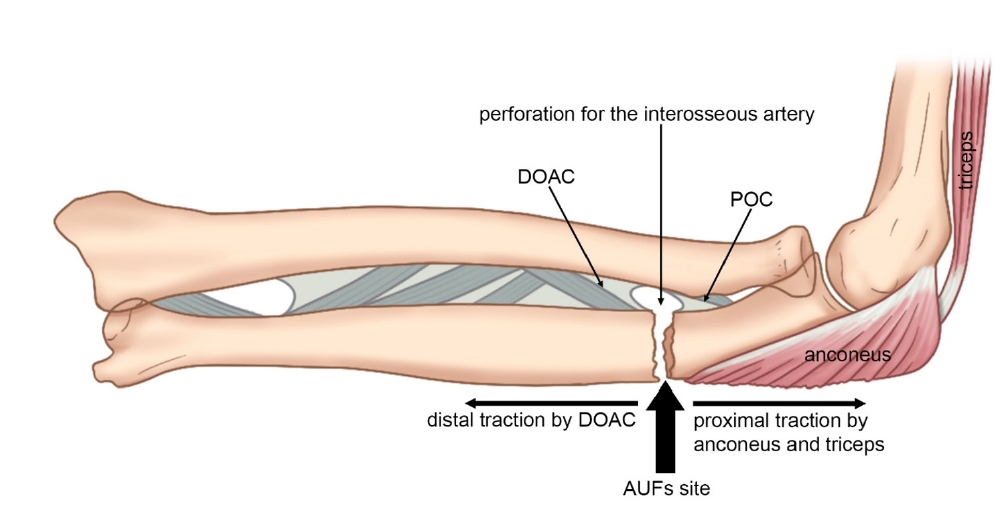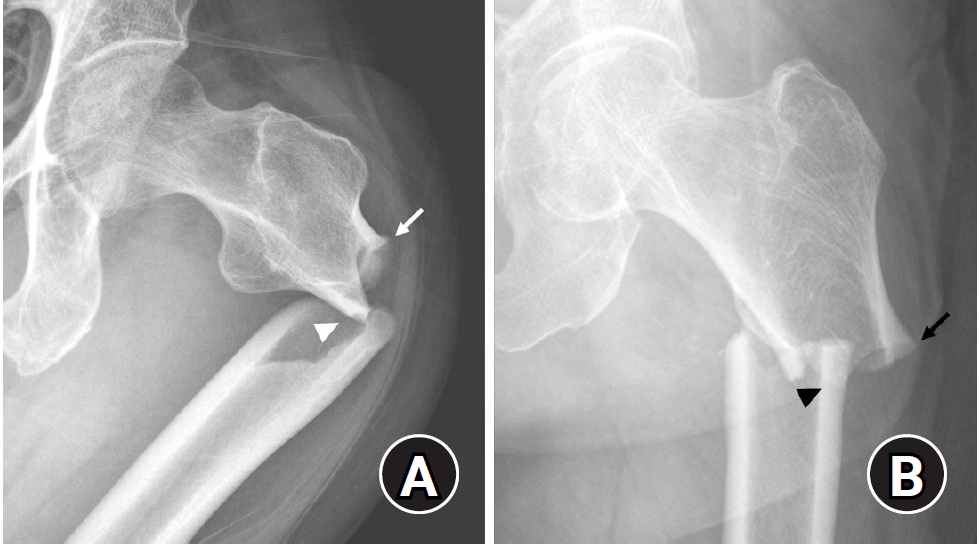Search
- Page Path
- HOME > Search
Review Articles
- Atypical ulnar fractures: a narrative review of current concepts and a case of bilateral surgical management
- Chi-Hoon Oh, Hyun Tak Kang, Jun-Ku Lee
- J Musculoskelet Trauma 2025;38(3):124-132. Published online July 24, 2025
- DOI: https://doi.org/10.12671/jmt.2025.00227

-
 Abstract
Abstract
 PDF
PDF - Atypical ulnar fractures (AUFs) are rare complications that are often linked to long-term antiresorptive therapy. Although atypical femoral fractures are well-studied, AUFs lack standardized diagnostic and treatment protocols. This review summarizes current knowledge on AUFs, including their pathophysiology, diagnostic criteria, and management. A case of bilateral AUFs treated with two distinct osteosynthesis methods is presented, emphasizing the principles of biological healing and mechanical stabilization.
- 1,192 View
- 34 Download

- Atypical femoral fractures: an update
- Won-Tae Cho, Jeong-Hyun Koh, Seungyeob Sakong, Jung-Taek Kim
- J Musculoskelet Trauma 2025;38(2):41-52. Published online March 28, 2025
- DOI: https://doi.org/10.12671/jmt.2025.00031

-
 Abstract
Abstract
 PDF
PDF - This narrative review provides an up-to-date overview of atypical femoral fractures (AFFs), emphasizing diagnostic criteria, epidemiology, pathophysiology, risk factors, and evaluation with screening strategies. AFFs are rare but significant complications associated with prolonged bisphosphonate (BP) therapy for osteoporosis. Although the pathogenesis of AFFs has not been fully elucidated, its primary mechanism is thought to involve impaired bone remodeling, leading to unhealed microfractures that progress to stress fractures under repetitive loading. AFFs can occur in various regions of the femur, influenced by femoral geometry and the lower limb axis. Other risk factors include prolonged steroid use, arthroplasty, genetic predispositions, and metabolic bone disorders. The diagnosis of AFFs is based on criteria established by the American Society for Bone and Mineral Research. Key radiographic features include lateral cortical transverse fracture lines and localized cortical thickening, typically with minimal or no comminution on the medial cortex. Dual-energy X-ray absorptiometry for screening tests and magnetic resonance imaging as an advanced imaging modality enable the early detection of incomplete fractures. This multi-modal approach facilitates the prompt identification of prodromal cortical changes, reducing the risk of complete fractures in high-risk populations, particularly patients undergoing prolonged BP therapy. Level of Evidence: V
- 8,298 View
- 276 Download

Case Report
- Insufficiency Fracture of Simultaneously Bilateral Femur Neck in Patient Treated with Long-Term Bisphosphonate Treatment - A Case Report -
- Seong Kee Shin, Hyung Gon Ryu, Dae Won Shin, Beom Su Han
- J Korean Fract Soc 2022;35(3):109-113. Published online July 31, 2022
- DOI: https://doi.org/10.12671/jkfs.2022.35.3.109
-
 Abstract
Abstract
 PDF
PDF - Bisphosphonate is used widely for osteoporosis management. On the other hand, some studies have reported that prolonged use of bisphosphonate without a proper resting period can cause insufficiency fracture and, in rare cases, fractures on the femur neck. This paper reports a case of an elderly patient who suffered bilateral femur neck insufficiency fractures induced by non-stopped long-term bisphosphonate therapy. The patient complained of pain in her buttocks at the first visit. During the admission period, inguinal area pain newly developed. Both a femur neck insufficiency fracture was observed on the hip radiographic image. Hip pinning and postoperative parathyroid hormone treatment were performed. The patient was discharged without specific complications and reported improvement in symptoms on the last follow-up. Several authors have reported one-sided femoral neck insufficiency fractures due to bisphosphonate use, but the present case is uncommon in that it occurred simultaneously in both femur necks. In addition, in the case of bilateral femur fractures, the walking ability after surgery is lower than that of one-sided fracture cases, so active rehabilitation is necessary.
- 408 View
- 1 Download

Review Article
- Bisphosphonate: An Invaluable Medication or Abandoned Acid?
- HoeJeong Chung, Jin Woo Lee, Jae Woong Um, Hoon-Sang Sohn
- J Korean Fract Soc 2021;34(3):122-130. Published online July 31, 2021
- DOI: https://doi.org/10.12671/jkfs.2021.34.3.122
-
 Abstract
Abstract
 PDF
PDF - Over the last two decades, bisphosphonate has widely been applied in the treatment of osteoporosis. We reviewed the various adverse effects, current trials involving diverse bone metabolic diseases, and the future direction of bisphosphonate. Acute phase reaction, hypocalcemia, ocular inflammation, and gastrointestinal disturbances are the well-known short-term side-effects of bisphosphonate. Long term side-effects include osteonecrosis of the jaws and atypical femur fracture. In the modern clinical setting, bisphosphonate is widely used in treatments for osteoporosis, osteopenia, osteoarthritis, rheumatoid arthritis, and metastatic bone cancer. Further studies are underway for expanding the application as a bone-targeting agent in bone-related diseases. Bisphosphonate remains useful and invaluable as the 1st line medication for osteoporosis. Considering the numerous clinical situations, including time to medication after fracture, duration of drug usage, and individual drug holiday, an optimal and proper use of bisphosphonate needs to be achieved. In the current scenario, bisphosphonate will retain a strong position due to good efficacy and effectiveness for osteoporosis treatment, and the precise ap- plication to various bone diseases. We anticipate a key role of bisphosphonate for future application in the treatment of metabolic bone diseases. Further studies and advancement are highly anticipated, considering the high potential of bisphosphonate for various uses.
-
Citations
Citations to this article as recorded by- Ocular Inflammation with Use of Oral Bisphosphonates
Jee Hyun Jeong, Kyung Tae Kang, Yu Cheol Kim
Journal of the Korean Ophthalmological Society.2025; 66(2): 128. CrossRef
- Ocular Inflammation with Use of Oral Bisphosphonates
- 454 View
- 4 Download
- 1 Crossref

Case Reports
- Treatment of Atypical Ulnar Fracture Associated with Bisphosphonate Therapy - A Case Report -
- Dong-Soo Kim, Ji-Kang Park, Eui-Sung Choi, Ho-Seung Jeong, Seok-Hyun Hong, Byung-Hyun Ahn
- J Korean Fract Soc 2020;33(2):101-104. Published online April 30, 2020
- DOI: https://doi.org/10.12671/jkfs.2020.33.2.101
-
 Abstract
Abstract
 PDF
PDF - Bisphosphonates can cause atypical fractures when taken for a long time. Atypical fractures appear mainly as femoral subtrochanteric or shaft fractures. On the other hand, reports of atypical fractures in the proximal ulna are relatively rare, with a high proportion of nonunion cases. This paper reports a case of nonunion after fixation for atypical fractures of the proximal ulna.
- 317 View
- 1 Download

- Ulnar Insufficiency Fractures in Patients on Prolonged Bisphosphonate Therapy: A Case Report
- Kyu Min Kong, Yong Uk Kwon, Young Kyung Min, Doo Yeol Kim
- J Korean Fract Soc 2019;32(3):143-147. Published online July 31, 2019
- DOI: https://doi.org/10.12671/jkfs.2019.32.3.143
-
 Abstract
Abstract
 PDF
PDF - Atypical fractures associated with prolonged bisphosphonate (BP) therapy rarely occur outside the femur, and the diagnostic criteria, appropriate treatment principles, and fixation methods for atypical ulnar fractures have not been established. The authors experienced the use of internal fixation with a metal plate and a new internal fixation method with an intramedullary nail in the treatment of an atypical ulnar fracture in a patient who had been on BP therapy for 10 to 20 years. This paper reports findings along with a review of the relevant literature.
-
Citations
Citations to this article as recorded by- Treatment of Atypical Ulnar Fracture Associated with Bisphosphonate Therapy: A Case Report
Dong-Soo Kim, Ji-Kang Park, Eui-Sung Choi, Ho-Seung Jeong, Seok-Hyun Hong, Byung-Hyun Ahn
Journal of the Korean Fracture Society.2020; 33(2): 101. CrossRef
- Treatment of Atypical Ulnar Fracture Associated with Bisphosphonate Therapy: A Case Report
- 594 View
- 1 Download
- 1 Crossref

- Atypical Fracture-Like Insufficiency Fracture of the Tibia with Prolonged Bisphosphonate Drug: A Case Report
- Min Jung Park, Su Jin Lee, Jin Hwa Kam, Yun Tae Lee, Ju Hyung Yoo, Hyun Cheol Oh, Joong Won Ha, Yung Park, Sang Hoon Park, Seong Hoon Kim, Han Kook Yoon
- J Korean Fract Soc 2017;30(3):137-141. Published online July 31, 2017
- DOI: https://doi.org/10.12671/jkfs.2017.30.3.137
-
 Abstract
Abstract
 PDF
PDF - Atypical femoral fracture related to a long-term bisphosphonate therapy has commonly been reported; however, a fracture at the site other than the femur has rarely been reported to date. Herein, we report a case of a patient on long-term bisphosphonate therapy who presented atypical tibial insufficiency fracture at the anterolateral aspect of diaphysis, without trauma. We, for the first time in Korea, present this case with a literature review.
-
Citations
Citations to this article as recorded by- Atypical Femoral Fracture Occurring at a Proximal Screw Insertion Site after Plate Removal in a Distal Femoral Fracture
Jin Woo Jin, Sung Jin Shin, Jong Min Jeon
Journal of the Korean Orthopaedic Association.2024; 59(4): 314. CrossRef
- Atypical Femoral Fracture Occurring at a Proximal Screw Insertion Site after Plate Removal in a Distal Femoral Fracture
- 468 View
- 2 Download
- 1 Crossref

- Insufficiency Fracture of Proximal Femur Shaft without Bisphosphonate Therapy: Report of Three Cases
- Suk Kyu Choo, Dae Yeon Jo, Hyoung Keun Oh
- J Korean Fract Soc 2013;26(3):217-220. Published online July 31, 2013
- DOI: https://doi.org/10.12671/jkfs.2013.26.3.217
-
 Abstract
Abstract
 PDF
PDF - There is a growing interest in the factors related to insufficiency fractures. We are going to report three insufficiency fracture cases which are considered to be caused by osteoporosis, rheumatoid arthritis, steroid use and femoral shaft bowing among the patients not taking bisphosphonate. All cases are caused by low energy trauma and among these cases, one patient is being presented with a prodromal symptom and another patient complains of both prodromal symptoms and bilateral lesions.
- 239 View
- 0 Download


 E-submission
E-submission KOTA
KOTA TOTA
TOTA TOTS
TOTS

 First
First Prev
Prev


